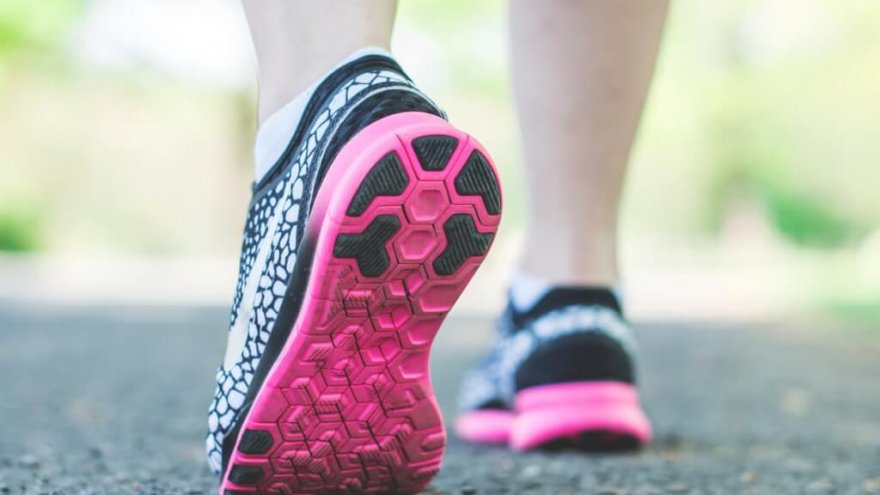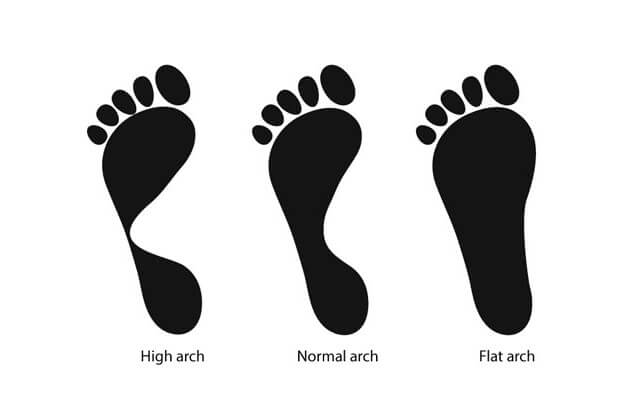How to Tell if You Have High Arches vs Flat Feet (Easy DIY Test)

Finding the perfect pair of running shoes can be a challenge, and the first thing you need to determine is whether you have high arches or flat feet. The good news is that measuring your arches at home is super simple (no fancy metal foot measurer required!), and you likely have all of the tools on hand.
Foot pain is a real problem for some runners and often boils down to the wrong type of running shoes for your feet.
Below, I wanted to dive into how you can measure your arches and what you can do once you discover if you have a high arched foot or flat feet.
The Easy Way to Measure Your Arches
The ‘wet test’ is the most effective and easier way to determine the pitch of your arches and only requires a little bit of water and a stiff piece of paper (cardboard works best).
When you get out of the shower, set a piece of cardboard on the bathroom floor and press the ball of your foot naturally into the surface. Your foot leaves an imprint in the cardboard will reveal your arch type.
Flat Feet: If your foot’s entire outline is imprinted into the cardboard, it means that you have flat feet.
High Arches: If there is a wide gap between the inside and outside of your foot, it means that you have high arches.
It’s as simple as that!

Now that you have determined the shape of your arches, let’s look into what type of running shoes you need.
I Have High Arches – What Does That Mean?
If you have a high arch of the foot, you likely suffer from issues such as over-pronation or supination because your body weight will naturally shift to one side of your foot. Without an even gait cycle, runners often suffer from things like knee pain, plantar fasciitis, tight arches, tight calf muscles and other foot problems.
High arches also mean that less of your foot and touches the ground as you walk or run, which puts more stress on the places where your feet touch the ground (heel of the foot, plantar fascia etc).
By selecting running shoes that provide extra support to your arches and your foot type, you will reduce impact absorption and engage in a more even gait cycle that results in less pain or injuries such as ankle sprains and splints.
What Types of Shoes Do High Arches Need?
High-arched runners benefit most from stability shoes since high arches, and overpronation often goes hand-in-hand. For your best line of defense from arch-induced foot pain, reach for shoes that utilize features such as guide rails that naturally push your foot into a nice and even gait cycle.
Some of the very best running shoes for high arch runners include:
Brooks Ghost: This shoe boasts a steep 12 mm drop and a plush DNA Loft midsole for unmatched impact absorption. It’s perfect for high arches and runners who want a good blend of speed and agility.
New Balance Fresh Foam 1080: Stability shoes have a reputation for being a little heavy and clunky, which is why this option is a great choice. It delivers high-end support to the arch of your foot with a more lightweight profile that keeps your stride nice and bright while cradling those arches in place.
Saucony Triumph: This is the Cadillac of running shoes. Saucony threw all of their pillowy cushioning features into this shoe that contours to your foot like a glove while limiting the impact your feet make with the ground. If your feet are screaming at the end of a long run, this shoe is sure to make your feet very happy.
I Have Flat Feet – What Does That Mean?
Flat feet can cause issues in your overall balance and often result in overpronation. Many runners feel that adding arch support may help correct their flat arches, but this solution can do more harm than good because it positions your foot at an unnatural angle.
Runners with flat feet sometimes suffer from swelling in the ankles, pain in the arches, heel pain and lower back pain.
What Types of Shoes Do High Arches Need?
The key to supporting flat feet is reaching for shoes with good stability features, a nice and wide toe box that allows your toes to splay inside of the shoe naturally, and a lower drop.
Below, I have gathered some of the very, very running shoes for all those flat-footed runners out there!
Hoka One One Arahi: With a modest 5 mm drop, high-end stability features, a nice and roomy toe box, and plush cushioning, this is a great choice for flat-footed runners. The addition of the J-frame helps to guide your foot into a nice and even gait cycle, and the EVA foam in the arches gives you a boost of energy return.
Altra Provision: This zero-drop running shoe contours to the shape of your foot for an incredibly comfortable fit. What makes this design perfect for flat-footed runners is the incredibly roomy toe box and high-profile upper that is made specifically for flat feet.
Brooks Ariel: One look at this straight-as-an-arrow shoe, and there is no mistaking that it is designed explicitly for flat-footed runners. The design of this shoe is made to mirror the shape of flat feet and provide high-end stability features and plush cushioning to keep your feet nice and supported as you run.
Additional Support?
If you already have a pair of running shoes that are causing pain, you don’t need to throw them away! A good pair of custom orthotics or even supportive socks can help mitigate pain and provide support without the need for new trainers.
For high arches, additional arch support is key. Socks such as Rockay Agile & Arch Support hug your arches for a boost of support and also help circulate blood to mitigate swelling and soreness.
New Balance Sport High Impact Insoles are super affordable and provide runners with a boost of impact absorption while hugging their arches in place.
For flat feet, PCSsole Inserts are a perfect choice to help keep your feet supportive while adding a boost of comfort to help mitigate pain on those long runs.
Keep Your Feet Happy
No two feet are alike, and finding the right shoes, socks, and orthotics is the key to a happy run and to foot health.
Whether you have high arches or flat feet, rest assured that there is the perfect pair of trainers out there that are built to eliminate pain for happy and healthy runs!Eas
Latest Articles
 Is Running on a Treadmill Easier Than Running Outside?Runners have their own preferences, whether it is treadmill running, running outside on the road, or exploring trails. So...
Is Running on a Treadmill Easier Than Running Outside?Runners have their own preferences, whether it is treadmill running, running outside on the road, or exploring trails. So... Is It OK to Use Trail Running Shoes on the Road?While trail running shoes can be used on roads, especially in situations where a runner encounters mixed terrains or pref...
Is It OK to Use Trail Running Shoes on the Road?While trail running shoes can be used on roads, especially in situations where a runner encounters mixed terrains or pref... How to Fix Sore Quads After Running?Rest, ice, gentle stretching, and over-the-counter pain relievers can help soothe sore quads after running. Also, ensure ...
How to Fix Sore Quads After Running?Rest, ice, gentle stretching, and over-the-counter pain relievers can help soothe sore quads after running. Also, ensure ... 10 Fruits With The Most Electrolytes to Replace Sports DrinksThese fruits are high in electrolytes such as potassium, magnesium, and calcium, essential for hydration, muscle function...
10 Fruits With The Most Electrolytes to Replace Sports DrinksThese fruits are high in electrolytes such as potassium, magnesium, and calcium, essential for hydration, muscle function...

